Search and Study of Marked Code Structures for a Spatially Distributed System of Small-Sized Airborne Radars
Abstract
1. Introduction
2. Analysis of the Level of Side Lobes of Modified Barker Codes with Asymmetric Alphabet
3. Generation of M-Sequences
4. Method for Searching for Modified M-Sequences
- (1)
- From Table 6, you need to choose several different polynomials, g1(x), g2(x), …, gn(x), of one order. The number of polynomials for the generation depends on the number of positions in the SD of the small-sized AR.
- (2)
- Generate the required number of M-sequences based on the diagram (see Figure 7), M1, M2, …, Mn sequences over polynomials g1(x), g2(x), …, gn(x), and bring their values to the symmetrical pair {1, −1}.
- (3)
- Construct a normalized ACF for each of the M-sequences obtained at step 2.
- (4)
- Determine the maximum modulo value of the SL of two ACFs obtained at step 3.
- (5)
- In the generated code sequences at step 2, it is required to replace the code element from the value −1 to the value −b.
- (6)
- Obtain the expressions for each lobe (main and side) of ACF depending on b.
- (7)
- Obtain the expressions for each BL for the normalized ACF, thereby forming a system of SL expressions.
- (8)
- Find the parameter b for which the SL value of the normalized ACF will be the smallest possible by solving the system of expressions obtained in step 7.
- (9)
- Verify that the ACF SL values found in step 8 are lower than the maximum SL level determined in step 4.
- (10)
- Make sure that the values of the CCF of the modified M-sequences M1, M2, ..., Mn are uniformly distributed.
5. Computer Experiments on the Search for Labeled Code Structures based on Modifications of M-Sequences
- (1)
- Polynomial: g1(x) = x5 + x2 + 1 initial conditions for generation: [0 0 0 1 0].
- (2)
- Polynomial: g2(x) = x5+ x3 + 1 initial conditions for generation: [0 0 0 0 1].
6. Conclusions
Author Contributions
Funding
Institutional Review Board Statement
Informed Consent Statement
Data Availability Statement
Conflicts of Interest
References
- Verba, V.S.; Tatarsky, B.G.; Ilchuk, A.R.; Lepekhina, T.A.; Maistrenko, E.V.; Merkulov, V.I.; Mikheev, V.A.; Neronsky, L.B.; Plushev, V.A.; Peshko, A.S.; et al. (Eds.) Radiolokacionnye Sistemy Aviacionno-Kosmicheskogo Monitoringa Zemnoj Poverhnosti i Vozdushnogo Prostranstva [Radar Systems for Aerospace Monitoring of the Earth’s Surface and Airspace]; Radiotekhnika Publication: Moscow, Russia, 2014; p. 576. (In Russian) [Google Scholar]
- Levanon, N.; Mozeson, E. Radar Signals. In Chichester; John Wiley& Sons: Hoboken, NJ, USA, 2005; 411p. [Google Scholar]
- Palo, F.D.; Galati, G.; Pavan, G.; Wasserzier, C.; Savci, K. Introduction to Noise Radar and Its Waveforms. Sensors 2020, 20, 5187. [Google Scholar] [CrossRef] [PubMed]
- Trukhachev, A.A. Radiolokacionnye Signaly i ih Primeneniya [Radar Signals and Their Applications]; Voenizdat Publication: Moscow, Russia, 2005; 320p. (In Russian) [Google Scholar]
- Sharov, S.N.; Tolmachev, S.G. Search for binary code sequences with low autocorrelation sidelobes by the evolutionary method. Informatsionno-Upravliaiushchie Sist. [Inf. Control Syst.] 2020, 1, 44–53. [Google Scholar] [CrossRef]
- Brest, J.; Boskovic, B. A Heuristic Algorithm for a Low Autocorrelation Binary Sequence Problem with Odd Length and High Merit Factor. IEEE Access 2018, 6, 4127–4134. [Google Scholar] [CrossRef]
- Rawat, B.S.; Trivedi, A.; Manhas, S.; Karwal, V. (Eds.) Advances in Signal. Processing and Communication; Springer: Singapore, 2019; p. 618. [Google Scholar]
- Ali, W.T. Detraction the clutter for the best binary phase codes that begot by genetic algorithm using wiener filter. Eur. J. Eng. Res. Sci. (EJERS) 2016, 1, 9–14. [Google Scholar] [CrossRef]
- Mahafza, B.R. Radar Systems Analysis and Design Using MATLAB; Chapman and Hall/CRC: Boca Raton, FL, USA, 2016; Volume 3, p. 743. [Google Scholar] [CrossRef]
- Nenashev, V.A.; Khanykov, I.G.; Kharinov, M.V. A Model of Pixel and Superpixel Clustering for Object Detection. J. Imaging 2022, 8, 274. [Google Scholar] [CrossRef] [PubMed]
- Nenashev, V.A.; Khanykov, I.G. Formation of Fused Images of the Land Surface from Radar and Optical Images in Spatially Distributed On-Board Operational Monitoring Systems. J. Imaging 2021, 7, 251. [Google Scholar] [CrossRef] [PubMed]
- Shepeta, A.P.; Nenashev, V.A. Accuracy characteristics of object location in a two-position system of small onboard radars. Inf. Control. Syst. 2020, 2, 31–36. [Google Scholar] [CrossRef]
- Mokhtari, A.; Ahmadi, A.; Daccache, A.; Drechsler, K. Actual Evapotranspiration from UAV Images: A Multi-Sensor Data Fusion Approach. Remote Sens. 2021, 13, 2315. [Google Scholar] [CrossRef]
- Klemm, R. (Ed.) Novel Radar Techniques and Applications. In Real Aperture Array Radar, Imaging Radar, and Passive and Multistatic Radar; Scitech Publishing: London, UK, 2017; Volume 1. [Google Scholar] [CrossRef]
- Klemm, R. (Ed.) Novel Radar Techniques and Applications. In Waveform Diversity and Cognitive Radar, and Target. Tracking and Data Fusion; Scitech Publishing: London, UK, 2017; Volume 2, p. 553. [Google Scholar]
- Beddar-Wiesing, S.; Bieshaar, M. Multi-Sensor Data and Knowledge Fusion A Proposal for a Terminology Definition. arXiv 2020, arXiv:2001.04171. [Google Scholar] [CrossRef]
- Mathuranathan, V. Wireless Communication Systems in Matlab, 2nd ed.; Independently Published: Chicago, IL, USA, 2020; p. 382. [Google Scholar]
- Ipatov, V.P. Shirokopolosnye Sistemy i Kodovoe Razdelenie Signalov. In Principy i Prilojeniya [Broadband Systems and Code Division of Signals. Principles and Applications]; Technosfera Publication: Moscow, Russia, 2007; 486p. (In Russian) [Google Scholar]
- Sorokin, A.V.; Shepeta, A.P.; Nenashev, V.A.; Wattimena, G.M. Comparative characteristics of anti-collision processing of radio signal from identification tags on surface acoustic waves. Informatsionno-Upravliaiushchie Sist. [Inf. Control Syst.] 2019, 98, 49–57. [Google Scholar] [CrossRef]
- Tsmots, I.; Riznyk, O.; Rabyk, V.; Kynash, Y.; Kustra, N.; Logoida, M. Implementation of FPGA-Based Barker’s-Like Codes. In Lecture Notes in Computational Intelligence and Decision Making; Advances in Intelligent Systems and Computing; Lytvynenko, V., Babichev, S., Wójcik, W., Vynokurova, O., Vyshemyrskaya, S., Radetskaya, S., Eds.; Springer: Cham, Switzerland, 2020; Volume 1020. [Google Scholar] [CrossRef]
- Taylor, J.D.; Anatoliy, B.; Elen, B. Signals, Targets, and Advanced Ultrawideband Radar Systems. In Advanced Ultrawideband Radar; James, D.T., Ed.; CRC Press: Boca Raton, FL, USA, 2016. [Google Scholar]
- Shepeta, A.P.; Nenashev, V.A.; Isakov, V.I.; Sentsov, A.A. Ultra-Wideband Signals in Location Measuring Devices for Generation and Processing; St. Petersburg State University of Aerospace Instrumentation: St. Petersburg, Russia, 2020; 56p, ISBN 978-5-8088-1523-0. [Google Scholar]
- Li, J.; Liu, Y.; Xu, H.; Wang, B.; Liu, L.; Chen, X. A High Signal–Noise Ratio UWB Radar for Buried Pipe Location Using Golay Complementary Sequences. Appl. Sci. 2019, 9, 5090. [Google Scholar] [CrossRef]
- Al-Qawasmi, A.-R.; Allawama, A. Improvement of UWB—Multiband OFDM BER performance using Barker signaling. Int. Conf. Electr. Eng. 2010, 7, 25–27. [Google Scholar] [CrossRef]
- Syanov, V.A. Suppression of Side Lobe Signals Based on Compound Barker Codes. Izv. Vyss. Uchebnykh Zaved. Rossii. Radioelektron. [J. Russ. Univ. Radioelectr.] 2017, 2, 53–56. (In Russian) [Google Scholar]
- Gavrishev, A.A.; Osipov, D.L. Construction of a criterion for assessing the quality of binary barker-like codes. T-Comm. 2022, 16, 11–16. [Google Scholar] [CrossRef]
- Yankevych, R.; Prudyus, I.; Miskiv, V.M. Use of genetic algorithm for optimal codes search. In Proceedings of the IEEE 15th International Conference on the Experience of Designing and Application of CAD Systems (CADSM), Polyana, Ukraine, 26 February–2 March 2019. [Google Scholar] [CrossRef]
- Dvornikov, S.V.; Dvornikov, S.S. An empirical approach to assessing the noise immunity of phase modulation signals. Inform. Autom. 2020, 19, 1280–1306. [Google Scholar] [CrossRef]
- Raghavarao, D. Some Optimum Weighing Designs. Ann. Math. Stat. 1959, 30, 295–303. [Google Scholar] [CrossRef]
- Maksimov, V.V.; Khrapovitsky, I.A. New composite Barker codes. Sci. Heritage 2020, 49, 28–35. [Google Scholar]

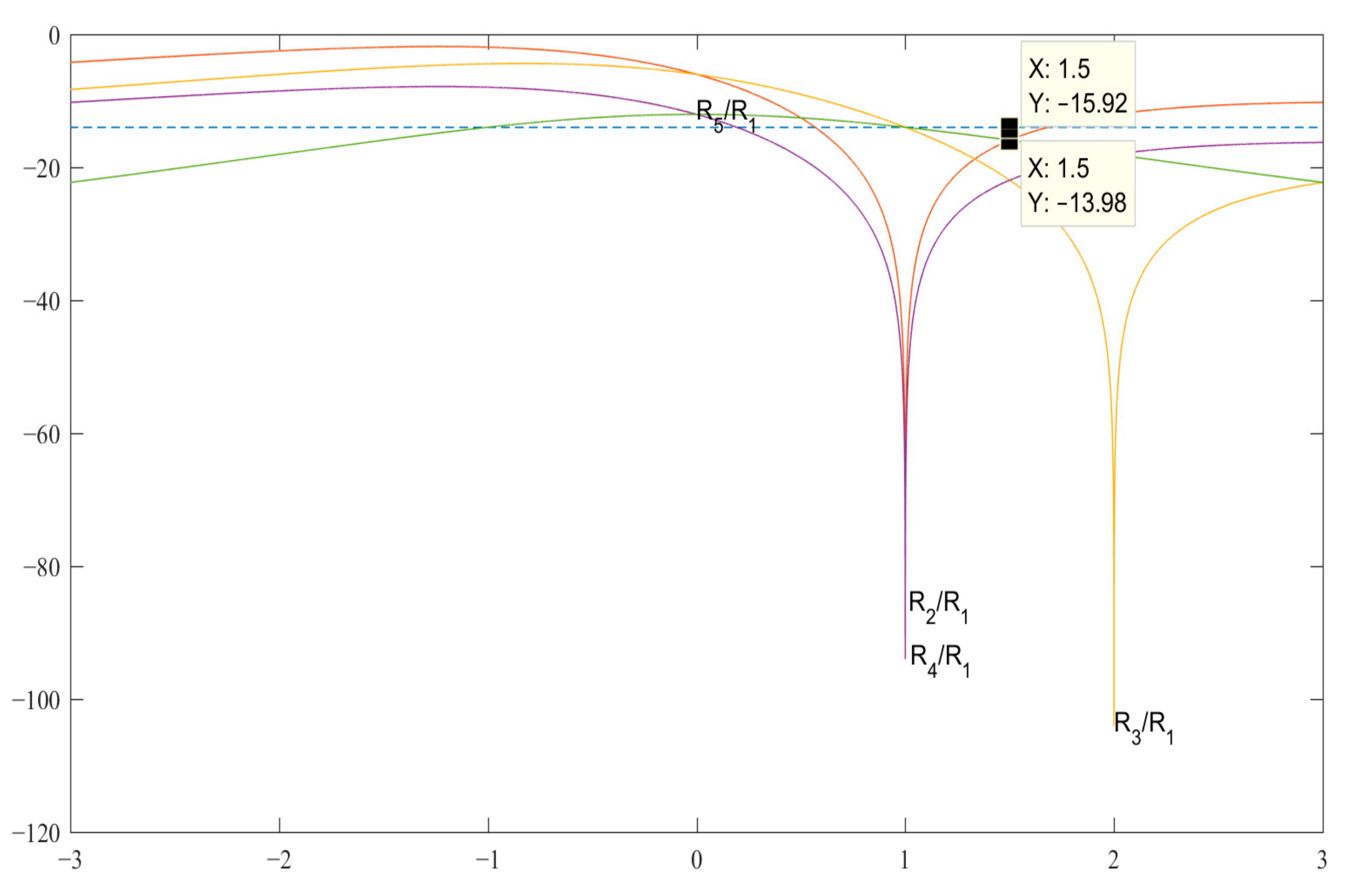

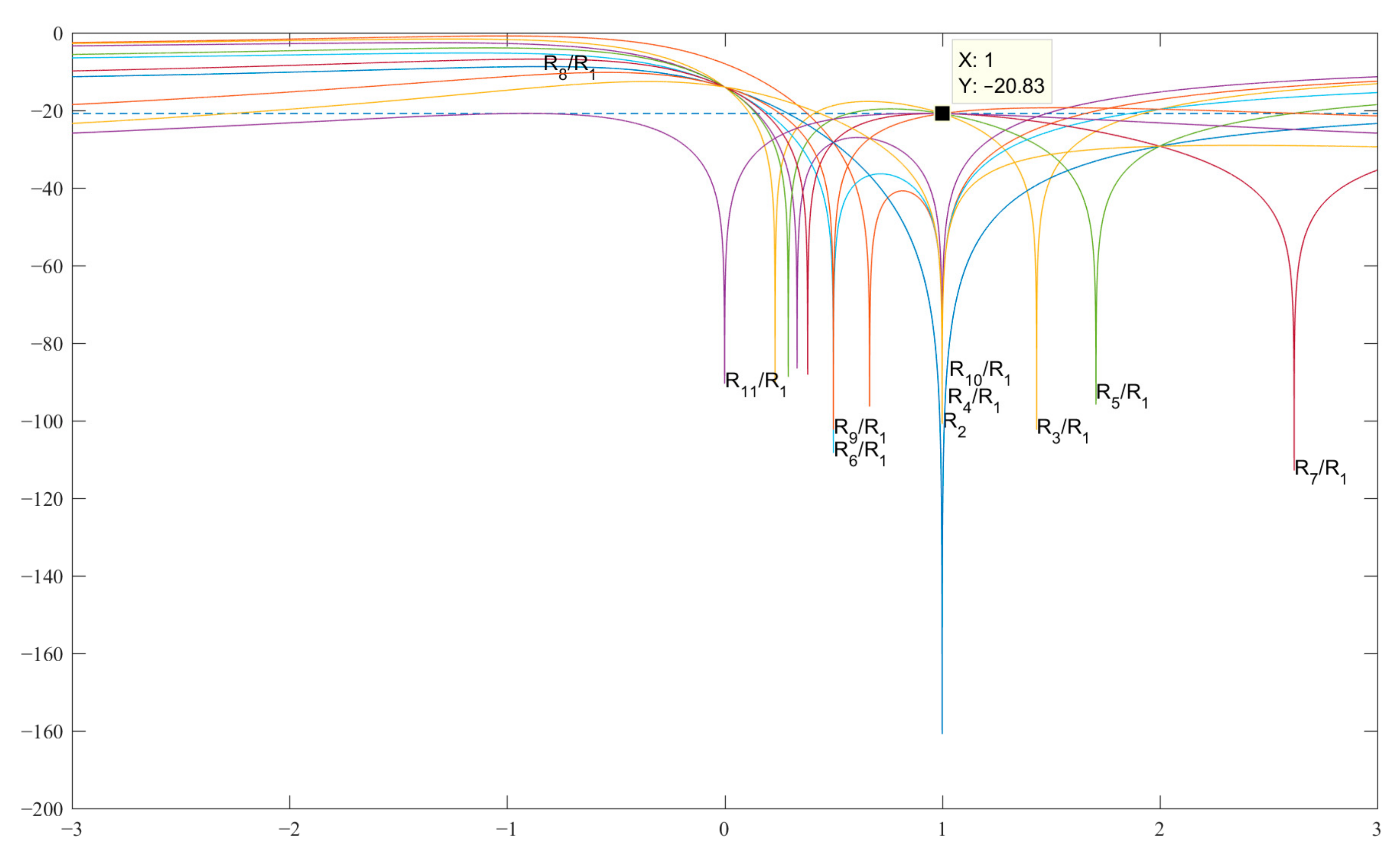
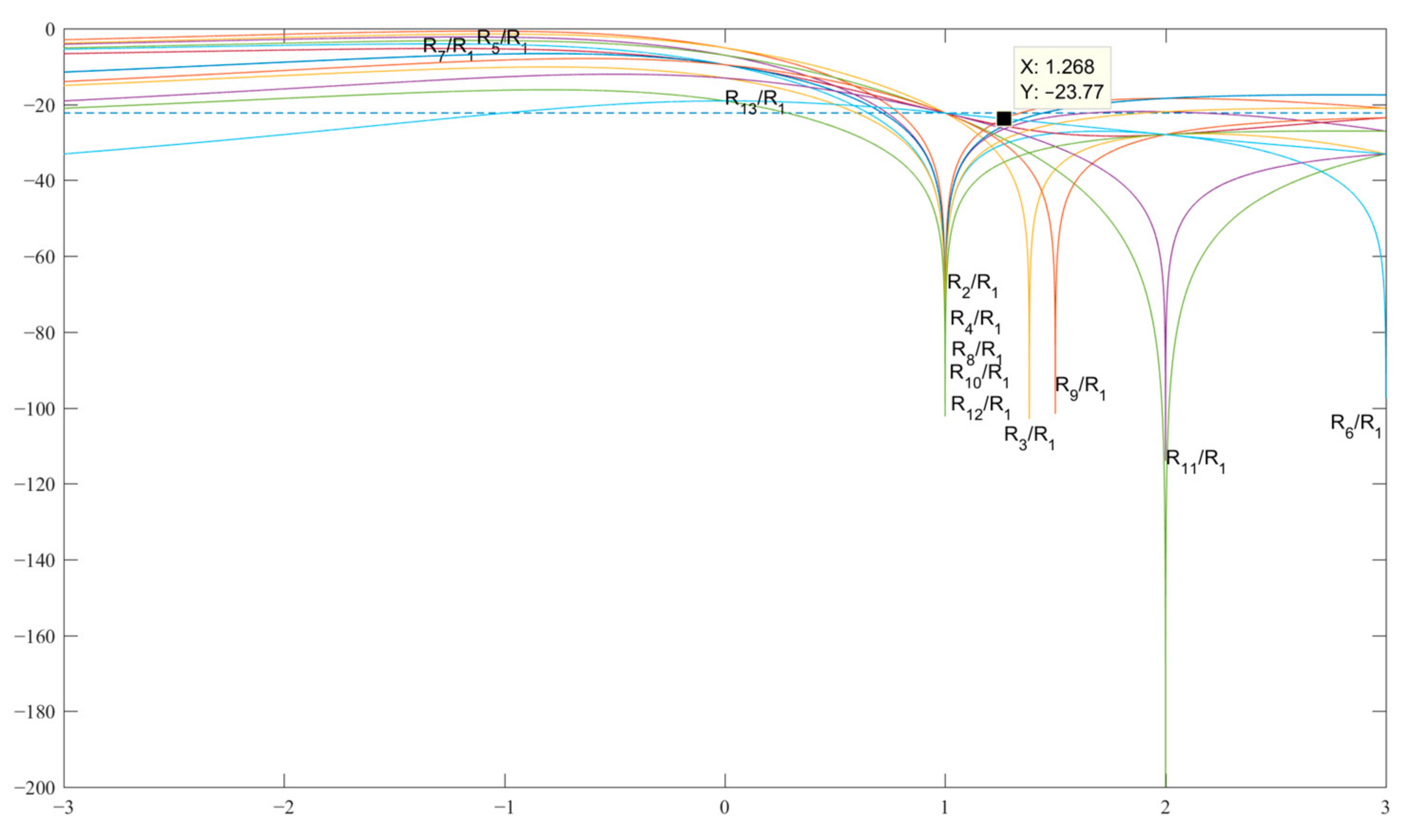

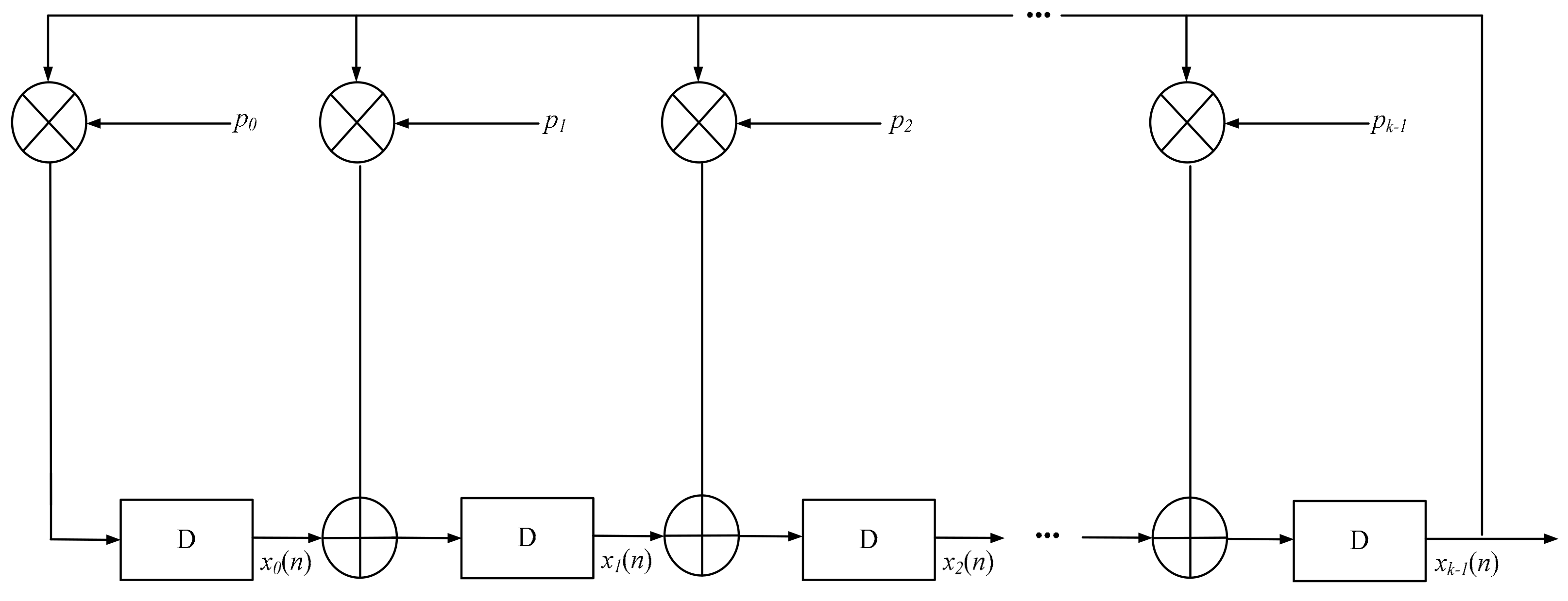
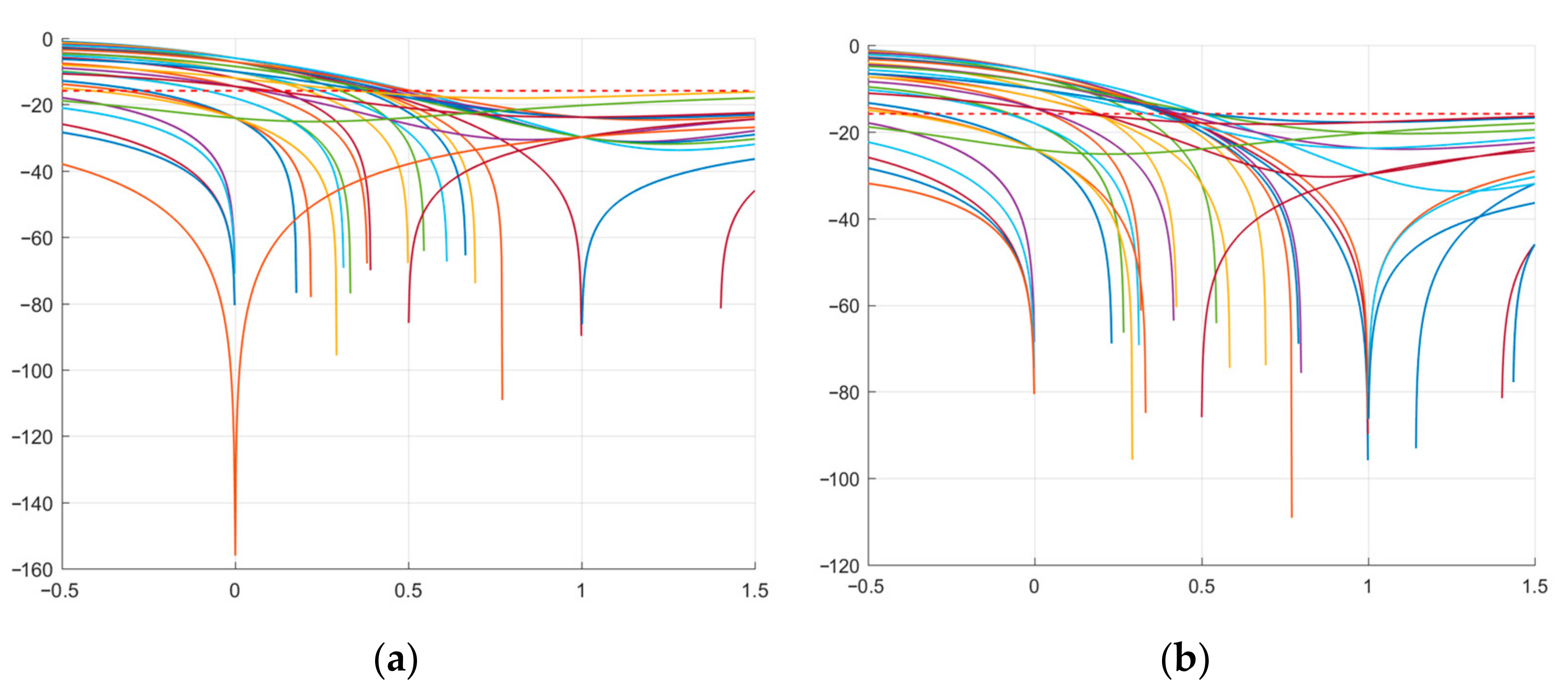
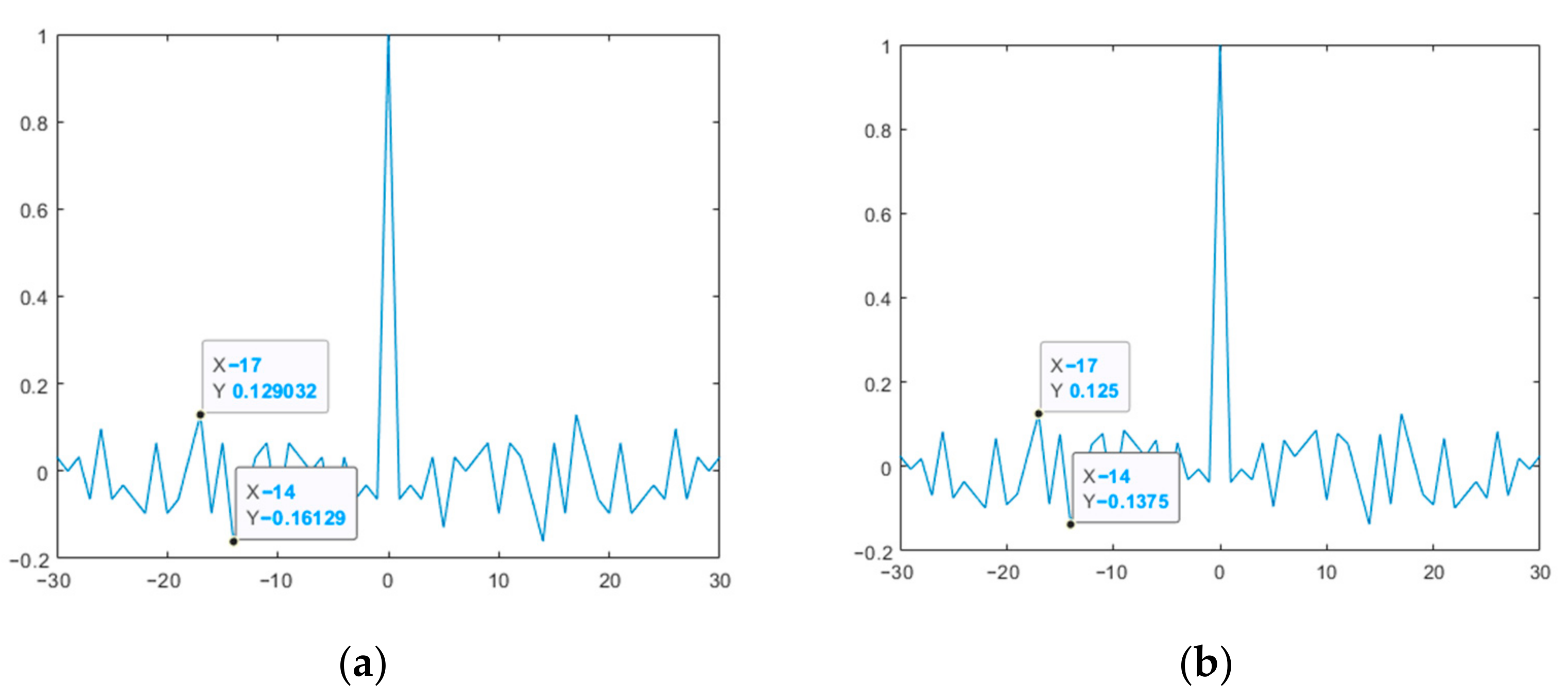


| Lobe Number ACF | Search Expressions b | Expressions to Search for a and b |
|---|---|---|
| R1 | b2 + 2 | 2a2 + b2 |
| R2 | −b + 1 | a2 − ab |
| R3 | −b | −ab |
| Lobe Number ACF | Search Expressions b | Expressions to Search for a and b |
|---|---|---|
| R1 | b2 + 4 | 4a2 + b2 |
| R2 | −2b + 2 | 2a2 − 2ab |
| R3 | −b + 2 | 2a2 − ab |
| R4 | −b + 1 | a2 − ab |
| R5 | 1 | a2 |
| Lobe Number ACF | Search Expressions b | Expressions to Search for a and b |
|---|---|---|
| R1 | 3b2 + 4 | 4a2 + 3b2 |
| R2 | b2 − 3b + 2 | 2a2 − 3ab + b2 |
| R3 | b2 − 3b + 1 | a2 − 3ab + b2 |
| R4 | (b − 1)2 | (a − b)2 |
| R5 | −2b + 1 | a2 − 2ab |
| R6 | −b + 1 | a2 − ab |
| R7 | −b | −ab |
| Lobe Number ACF | Search Expressions b | Expressions to Search for a and b |
|---|---|---|
| R1 | 6b2 + 5 | 5a2 + 6b2 |
| R2 | 3b2 − 5b + 2 | 2a2 − 5ab + 3b2 |
| R3 | 3b2 − 5b + 1 | a2 − 5ab + 3b2 |
| R4 | 3b2 − 4b + 1 | a2 − 4ab + 3b2 |
| R5 | 2b2 − 4b + 1 | a2 − 4ab + 2b2 |
| R6 | 2b2 − 3b + 1 | a2 − 3ab + 2b2 |
| R7 | b2 − 3b + 1 | a2 − 3ab + b2 |
| R8 | (b − 1)2 | (a − b)2 |
| R9 | −2b + 1 | a2 − 2ab |
| R10 | −b + 1 | a2 − ab |
| R11 | −b | −ab |
| Lobe Number ACF | Search Expressions b | Expressions to Search for a and b |
|---|---|---|
| R1 | 4b2 + 9 | 9a2 + 4b2 |
| R2 | b2 − 6b + 5 | 5a2 − 6ab + b2 |
| R3 | b2 − 5b + 5 | 5a2 − 5ab + b2 |
| R4 | b2 − 5b + 4 | 4a2 − 5ab + b2 |
| R5 | (b − 2)2 | (2a − b)2 |
| R6 | b2 − 4b + 3 | 3a2 − 4ab + b2 |
| R7 | b2 − 3b + 3 | 3a2 − 3ab + b2 |
| R8 | −3b + 3 | 3a2 − 3ab |
| R9 | −2b + 3 | 3a2 − 2ab |
| R10 | −2b + 2 | 2a2 − 2ab |
| R11 | −b + 2 | 2a2 − ab |
| R12 | −b + 1 | a2 − ab |
| R13 | 1 | a2 |
| Degree of Polynomial L | The Length of the Generated Sequence N = 2L − 1 | Type of Polynomials g(x) for Generating the M-Sequence |
|---|---|---|
| 3 | 7 | x3 + x + 1 x3 + x2 + 1 |
| 4 | 15 | x4 + x + 1 x4 + x3 + 1 |
| 5 | 31 | x5 + x2 + 1 x5 + x3 + 1 x5 + x3 + x2 + x + 1 x5 + x4+ x3 + x + 1 x5 + x4 + x3 + x2 + 1 x5 + x4 + x2 + x + 1 |
| 6 | 63 | x6 + x + 1 x6 + x4 + x3 + x + 1 x6 + x5 + 1 x6 + x5 + x2 + x+ 1 x6 + x5 + x3 + x2+ 1 x6 + x5 + x4 + x + 1 |
| 7 | 127 | x7 + x + 1 x7 + x3 + 1 x7 + x3 + x2 + x + 1 x7 + x4 + 1 x7 + x4 +x3 + x2 + 1 x7 + x5 + x2 + x + 1 x7 + x5 + x3 + x + 1 x7 + x5 + x4 +x3 + 1 x7 + x5 + x4 +x3+ x2 + x + 1 x7 + x6 + 1 x7 + x6 + x3 + x + 1 x7 + x6 + x4 + x2 + 1 x7 + x6 + x4 + x + 1 x7 + x6 + x5 + x2 + 1 x7 + x6 + x5 + x3 + x2 + x + 1 x7 + x6 + x5 + x4 + 1 x7 + x6 + x5 + x4 + x2 + x + 1 x7 + x6 + x5 + x4 + x3 + x2 + 1 |
| 8 | 255 | x8 + x4 + x3 + x2 + 1 x8 + x5 + x3 + x + 1 x8 + x5 + x3 + x2 + 1 x8 + x6 + x3 + x2 + 1 x8 + x6 + x5 + x + 1 x8 + x6 + x5 + x2 + 1 x8 + x6 + x5 + x3 + 1 x8 + x6 + x5 + x4 + 1 x8 + x6 + x4 + x3 + x2 + x + 1 x8 + x6 + x5 + x + 1 x8 + x7 + x2 + x + 1 x8 + x7 + x3 + x2 +1 x8 + x7 + x5 + x3 +1 x8 + x7 + x6 + x5 + x2 + x +1 x8 + x7 + x6 + x5 + x4 + x2 +1 x8 + x7 + x6 + x +1 |
| 9 | 511 | x9 + x4 + 1 x9 + x4 + x3 + x +1 x9 + x5 + 1 x9 + x5 + x3 + x2 + 1 x9 + x5 + x4 + x + 1 x9 + x6 + x4 + x3 + 1 x9 + x7 + x2 + x +1 x9 + x7 + x5 + x +1 x9 + x7 + x5 + x2 +1 x9 + x7 + x6 + x4 + 1 x9 + x8 + x6 + x5 + x4 + x3 + x2 +x +1 x9 + x8 + x7 + x6 + x5 + x4 + x3 + x +1 |
| Number Lobe ACF | Expressions for Finding b by g1(x) L = 5 | Expressions for Finding b by g2(x) L = 5 | Number Lobe ACF | Expressions for Finding b by g1(x) L = 5 | Expressions for Finding b by g2(x) L = 5 |
|---|---|---|---|---|---|
| 1 | 15b2 + 16 | 15b2 + 16 | 17 | 3b2 − 9b + 3 | 2b2 − 10b + 3 |
| 2 | 6b2 − 16b + 8 | 7b2 − 15b + 8 | 18 | 5b2 − 5b + 4 | 2b2 − 8b + 4 |
| 3 | 6b2 − 15b + 8 | 6b2 − 15b + 8 | 19 | 4b2 − 6b + 3 | 2b2 − 8b + 3 |
| 4 | 5b2 − 15b + 8 | 5b2 − 15b + 8 | 20 | 3b2 − 7b + 2 | 2b2 − 8b + 2 |
| 5 | 6b2 − 13b + 8 | 5b2 − 14b + 8 | 21 | 2b2 − 7b + 2 | 2b2 − 7b + 2 |
| 6 | 4b2 − 15b + 7 | 4b2 − 15b + 7 | 22 | 3b2 − 4b + 3 | 4b2 − 3b + 3 |
| 7 | 5b2 − 12b + 8 | 5b2 − 12b + 8 | 23 | 2b2 − 6b + 1 | 3b2 − 5b + 1 |
| 8 | 5b2 − 12b + 7 | 5b2 − 12b + 7 | 24 | 2b2 − 5b + 1 | 3b2 − 4b + 1 |
| 9 | 5b2 − 11b + 7 | 4b2 − 12b + 7 | 25 | 2b2 − 4b + 1 | 2b2 − 4b + 1 |
| 10 | 5b2 − 10b + 7 | 4b2 − 11b + 7 | 26 | 2b2 − 4b | 2b2 − 4b |
| 11 | 4b2 − 12b + 5 | 3b2 − 13b + 5 | 27 | 3b2 − b + 1 | 3b2 − b + 1 |
| 12 | 5b2 − 9b + 6 | 5b2 − 9b + 6 | 28 | b2 − 3b | 2b2 − 2b |
| 13 | 4b2 − 9b + 6 | 5b2 − 8b + 6 | 29 | 2b2 − b | 2b2 − b |
| 14 | 3b2 − 10b + 5 | 5b2 − 8b + 5 | 30 | b2 − b | b2 − b |
| 15 | 2b2 − 11b + 4 | 5b2 − 8b + 4 | 31 | b2 | −b |
| 16 | 4b2 − 7b + 5 | 5b2 − 6b + 5 |
| N | System Polynomials | The Value of b without Modification and with it | Level of SL in dB | The Difference from the SL Level at {1, −1} | The Nature of the CCF Values |
|---|---|---|---|---|---|
| 15 | x4 + x + 1 | −1 −2 | −11.4806 −13.0641 | 1.5835 | UC |
| 15 | x4 + x3 + 1 | −1 −0.6667 | −11.4806 −13.9793 | 2.4987 | UC |
| 31 | x5 + x2 + 1 | −1 −0.7387 | −14.2642 −16.0330 | 1.7688 | UC |
| 31 | x5 + x3+ 1 | −1 −0.7387 | −15.8478 −17.3107 | 1.4629 | UC |
| 31 | x5 + x3+ x2+ x + 1 | −1 −1.5469 | −14.2642 −15.2345 | 0.9703 | UC |
| 31 | x5 + x4 + x2+ x + 1 | −1 −0.7387 | −15.8478 −17.6782 | 1.8304 | UC |
| 31 | x5 + x4 + x3 + x2 + 1 | −1 −0.6835 | −14.2642 −16.9058 | 2.6416 | UC |
| 63 | x6 + x + 1 | −1 −1.3334 | −20.4238 −20.7396 | 0.3158 | UC |
| 63 | x6 + x5 + 1 | −1 −0.7998 | −17.9250 −19.1452 | 1.2202 | UC |
| 63 | x6 + x5 + x3 + x2 + 1 | −1 −1.3334 | −19.0849 −19.2976 | 0.2127 | UC |
| 63 | x6 + x5 + x4 + x + 1 | −1 −1.3334 | −17.9250 −18.7051 | 0.7801 | UC |
| 127 | x7 + x + 1 | −1 −1.2146 | −21.2482 −21.7965 | 0.5483 | UC |
| 127 | x7 + x3 + 1 | −1 −0.8498 | −21.2482 −22.1399 | 0.8917 | UC |
| 127 | x7 + x3 + x2+ x + 1 | −1 −1.2146 | −21.2482 −21.4885 | 0.2403 | UC |
| 127 | x7 + x4 + 1 | −1 −0.8498 | −20.4924 −21.0648 | 0.5724 | UC |
| 127 | x7 + x4 + x3 + x2 + 1 | −1 −1.2146 | −20.4924 −21.1896 | 0.6972 | UC |
| 127 | x7 + x5 + x4 + x3 + 1 | −1 −0.8498 | −21.2482 −22.0346 | 0.7864 | UC |
| 255 | x8 + x4+ x3+ x2 + 1 | −1 −0.8814 | −23.5218 −24.2805 | 0.7587 | UC |
| 255 | x8 + x6 + x3 + x2 + 1 | −1 −0.8886 | −24.0484 −24.4268 | 0.3784 | UC |
| 255 | x8 + x6 + x4 + x3 + x2 + 1 | −1 −0.8886 | −23.5218 −24.1275 | 0.6057 | UC |
| 255 | x8 + x6 + x5 + x4 + 1 | −1 −0.8886 | −24.0484 −24.6809 | 0.6325 | UC |
| 255 | x8 + x6 + x4 + x3 + x2 + x + 1 | −1 −0.8886 | −23.5218 −24.1275 | 0.6057 | UC |
| 511 | x9 + x4 + 1 | −1 −0.9186 | −27.7240 −28.0037 | 0.2797 | UC |
| 511 | x9 + x4 + x3 + x + 1 | −1 −1.0970 | −26.9339 −27.2522 | 0.3184 | UC |
| 511 | x9 + x5 + x3 + x2 + 1 | −1 −0.8714 | −26.9339 −27.5418 | 0.6080 | UC |
| 511 | x9 + x7 + x6 + x4 + 1 | −1 −0.8338 | −26.9339 −27.6126 | 0.6787 | UC |
| 511 | x9 + x8 + x6 + x5 + x4+ x3 + x2 + x +1 | −1 −0.9186 | −26.9339 −27.1297 | 0.1959 | UC |
Disclaimer/Publisher’s Note: The statements, opinions and data contained in all publications are solely those of the individual author(s) and contributor(s) and not of MDPI and/or the editor(s). MDPI and/or the editor(s) disclaim responsibility for any injury to people or property resulting from any ideas, methods, instructions or products referred to in the content. |
© 2023 by the authors. Licensee MDPI, Basel, Switzerland. This article is an open access article distributed under the terms and conditions of the Creative Commons Attribution (CC BY) license (https://creativecommons.org/licenses/by/4.0/).
Share and Cite
Nenashev, V.A.; Nenashev, S.A. Search and Study of Marked Code Structures for a Spatially Distributed System of Small-Sized Airborne Radars. Sensors 2023, 23, 6835. https://doi.org/10.3390/s23156835
Nenashev VA, Nenashev SA. Search and Study of Marked Code Structures for a Spatially Distributed System of Small-Sized Airborne Radars. Sensors. 2023; 23(15):6835. https://doi.org/10.3390/s23156835
Chicago/Turabian StyleNenashev, Vadim A., and Sergey A. Nenashev. 2023. "Search and Study of Marked Code Structures for a Spatially Distributed System of Small-Sized Airborne Radars" Sensors 23, no. 15: 6835. https://doi.org/10.3390/s23156835
APA StyleNenashev, V. A., & Nenashev, S. A. (2023). Search and Study of Marked Code Structures for a Spatially Distributed System of Small-Sized Airborne Radars. Sensors, 23(15), 6835. https://doi.org/10.3390/s23156835





